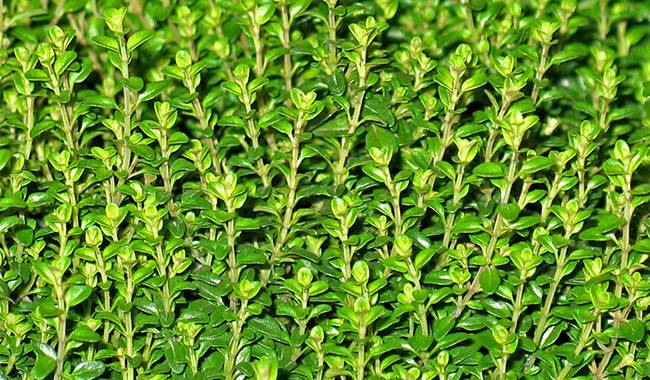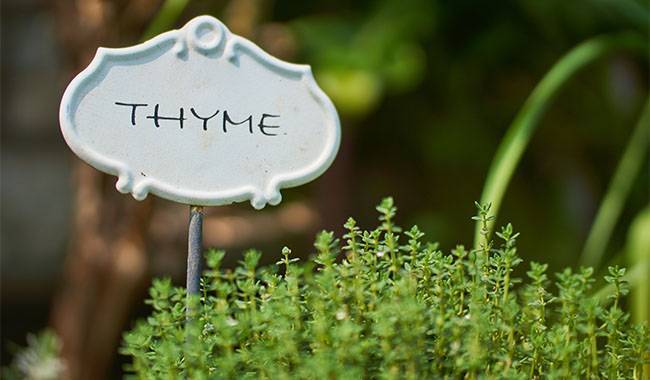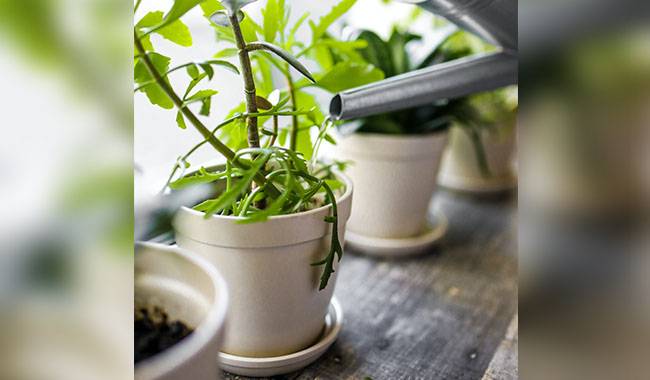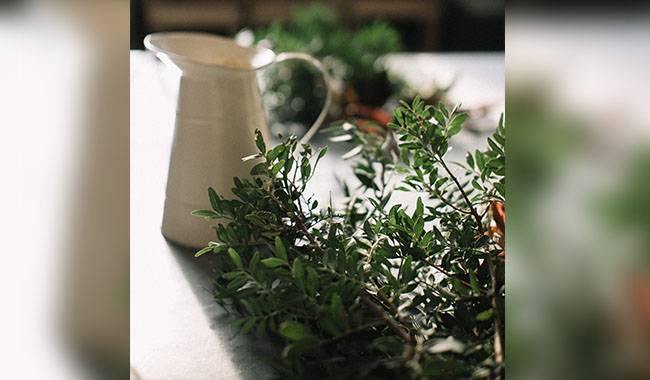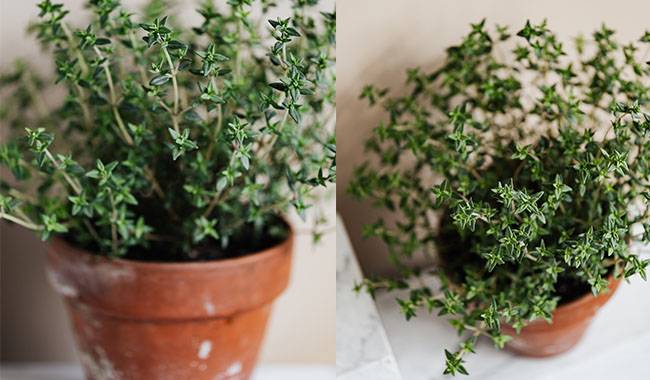
Thyme is widely used in culinary, medical, and cosmetic applications. It is rapidly gaining popularity among housewives due to its aroma, unusual flavor, and useful properties.
To grow thyme in how to grow thyme in a pot, it must be planted correctly, providing the necessary light, optimum temperature, and humidity.
WHY IS THYME SO POPULAR?
Thyme is valued not only for its beautiful appearance and fragrant aroma but also for its excellent medicinal properties.
In folk medicine. Thyme tea is fragrant and rich in useful vitamins, active ingredients that soothe the nervous system, eliminate pain, cope with colds, and many other diseases.
From its leaves and flowers make decoctions, infusions, essential oils. Dried thyme herbs are added to pillows for a deeper and healthier sleep. In the old days, thyme was used to fumigate rooms to get rid of germs and pests.
BENEFITS OF THYME AND ITS USES
Thyme is often referred to as the herb of witches and Vedas. The ancient Slavs revered thyme as a sacred plant.
In pagan rituals, it was used to burn on bonfires to attract the mercy of the gods. In pagan rituals, thyme was used to burn on bonfires to attract the favor of the gods.
Thyme is a wonderful herb with a pleasant flavor and many beneficial effects. In addition, this herb has some decorative properties, which is an added bonus when cultivated in living room conditions.
Using thyme in the home can be done in the following cases.
Use thyme for cooking and add it in moderation due to its strong natural flavor.
THYME: WHICH VARIETY IS POPULAR TO GROW?
Although there are more than 300 varieties of this plant, only four species are grown in garden plots. Its medicinal and decorative properties are the most obvious.
Marshall’s thyme. Used to treat eye diseases.
Thyme creeper. Planting and post-care are useful for treating cold and cough, stomach aches, and promoting digestion.
Common thyme. This variety has been specially bred. It is used to treat runny nose, colds, gastritis, and pancreatitis. Thyme tea is a good antiseptic. Plant this thyme in flower beds and decorate the site.
Thyme Lemon. The leaves are greenish-yellow in color and the plant has a pleasant lemon smell.
Feel free to choose one of them!
GATHERING THYME
Collect the herb if you want to dry it for future introduction into a spice mixture or save it for a decoction, just in case.
Take only the flowering plants. Slant the stem and cut it with a sharp knife. By breaking off the branches, irreparable damage is done to the entire bush.
Harvesting thyme during flowering
Thyme should be dried according to general regulations, spread on a sack or gauze, and placed in a cool place. The herbs can also be hung in bunches in the attic to dry in the sun.
HOW TO GROW THYME?
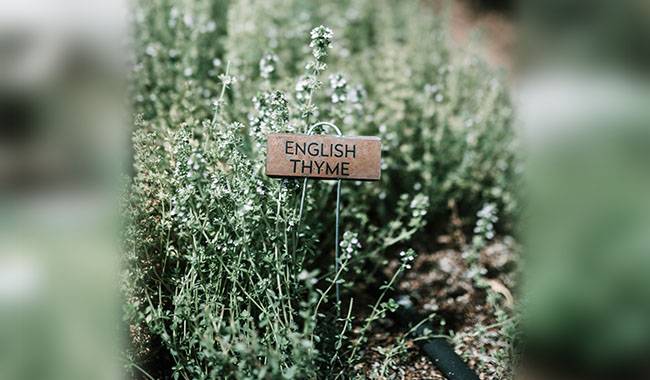
Growing thyme in the open ground does not require superb effort or the application of special knowledge.
Thyme perfectly tolerates the conditions of non-droughty summers and snowy winters. For fast growth and development, abundant flowering requires a lot of water, so the climate of the Moscow region creates the best conditions for him.
Bred from wild varieties, thyme grows well on any soil except acidic clay. Strong frosts do not scare this plant either.
If thyme is planted in a warm, sunny spot in a garden plot, it will grow healthily and quickly. To prevent the stem from rotting during the off-season when it is over-watered, cover the soil next to the stem with small pebbles or gravel for drainage.
Thyme looks great as a decorative element for garden paths. Planting it at the edge of a pathway gives it a cultivated look.
This plant is also suitable for rose gardens and alpine landscaping and is a good decoration for ponds.
And if planted near a house, you can not only get aesthetic pleasure looking at its intricate inflorescence but also breathe in the scent of flowers in the early morning and evening. Planting different species of thyme in flower beds can enhance the decorative effect.
HOW IS THIS PLANT PROPAGATED?
Thyme can be grown in three ways.
- Thyme seeds are planted in early spring. You can plant this plant in the late fall. In this case, sow the seeds before the onset of frost to prevent them from freezing. First make sure that the soil is prepared: dig it, loosen it, and remove weeds and other plant roots. Then apply compost. Instead, you can add well-rotted manure and mineral fertilizer, urea, all mixed with the soil.
- Now the seeds can be sown. After sowing, cover the seeds with soil, water them and additionally cover the bed with coarse sand. This will prevent water from being trapped in the area where the seedlings are growing.
- When the plants have grown a little, the seedlings should be thinned slightly to make them stronger, healthier, and more viable.
PLANTING SEEDLINGS
A thyme seedling can be planted in a vacant lot. To do this, sow the seeds in a special container and cover them with the film. Wait until they will germinate and sprout.
After about a month, transfer the grown plants to the open air to acclimatize and harden them.
If after 14 days the plants continue to grow actively and look healthy and neat, they are transplanted to a permanent open ground, the soil is dug beforehand and enriched with fertilizer and trace elements.
PLANT PLANTS WITH WELL-DEVELOPED ROOTSTOCKS
Thyme can be purchased from amateur gardeners at the market or in stores. It is important to note that when buying rhizomes with open roots, pay attention to the condition of the roots, stems, and leaves.
It is necessary to buy only healthy plants. If in doubt, it is best to refuse the purchase immediately. The roots must be well developed.
However, even a weak root system can be improved, and when the roots go into growth, new roots will appear from the stem of the plant. The main thing is that there is no decay or insect damage on it.
The plant should be robust, with a sturdy stem and dense, glossy, elastic leaves. A slightly wilted plant should not be purchased. It may wither over time or it may wilt completely.
Growing thyme with a closed root system and buying it in a special place will not cause difficulties. The plant should be carefully removed from the container, checked for decay, cleaned and righted if necessary, and then planted in prepared soil. Water and cover near the stem for drainage.
HOW TO CHOOSE A PLANTING LOCATION?
Thyme is best planted in a southern, sunny part of the garden.
If you plant it in the shade, its bushes will look loose, the leaves will be small and the stems will stretch.
It will be more difficult to accumulate the ideal concentration of substances and essential oils useful for him. An approximately pleasant aroma is impossible. The plant simply cannot produce a strong odor.
Thyme, which grows on the warm, sunny side, takes the form of a small, dense shrub. If its leaves and branches are cut regularly, it grows wider.
With proper care, thyme grass can take on a bulbous shape in the fall. This plant will look especially good in a flower bed and can be used as a decoration for any flower garden.
COLLECTION AND STORAGE
The edible and medicinal thyme herbs are harvested twice during the growing season. in June, the flowers and herbs contain the most flavorful and medicinal substances. The second cutting of the green mass is planned for the end of August.
The harvest of the herbs is commemorated especially on Church feasts such as Pentecost and the Assumption. There is a popular belief that these harvests multiply the positive effects of the herbs.
Thyme has a weak root system with shallow roots that do not tolerate hand harvesting. The only proper way to harvest these aromatic herbs is to cut them.
Bale the raw material to dry and hang it in a dry place, out of direct sunlight. A small amount of thyme can be dried in a thin layer at home or in a place protected from the sun and rain. Drying is crucial.
Thyme is stored by grinding or milling the thyme and removing the stem. Ready to use, the powder is poured into an airtight container such as a coffee can.
The container should be kept in a dark place, such as a kitchen cupboard. Tight-fitting paper and canvas bags are suitable for dried herbs, but they will lose the fragrance of the essential oil. The properties of the plant can be preserved for up to two years.
Cultivation of thyme is justified in several cases: for cooking, for decorating and flavoring the garden, for medicinal purposes. The unpretentious culture can grow in harsh conditions unsuitable for other plants.
Thyme is easy to grow due to its resistance to changes in weather conditions and adaptability. With proper care, the plant grows rapidly and has an abundant and prolonged flowering period.
CARE OF THYME
The care of thyme is not at all tedious.
Watering
A plant can go for a long time without water. However, it should still be watered in the dry summer months.
Replanting
To make the shrub look better, dig away the soil from its shoots. The shoots are placed in a pit and covered with freshly fertilized soil. To improve reliability, you can press them with special staples. With time, new roots will form and the sprouted plants can be planted in other areas.
Pruning
Thyme is pruned during the flowering period. At this time, the concentration of essential oils in its leaves and flowers is at its highest. After pruning, cover the plant with loose soil and water it. The cut stems, flowers, and leaves are dried in a cool place and then packed in canvas bags.
Gardeners have long had a fondness for this low-growing groundcover herb, with its carpet of flowers and distinctive scent.
But thyme isn’t just grown for garden design purposes. The plant, commonly known as thyme, has long been noted for its medicinal value and its ability to flavor meat dishes, soups, salads, and marinades. In ancient Egypt, thyme was used in rituals.
CAN THYME BE GROWN IN POTS?
Many people want to know if they can grow the spice at home. Thyme is very suitable for growing in an apartment because it is not too fussy and does not require much care.
Therefore, even people who have no experience in growing thyme can cope with planting and growing spices.
To plant, you just need to choose a suitable container for the spice, plant it, and place it in a well-lit room.
If you grow it in your apartment, you will have to water it regularly to prevent the soil from drying out and fertilize it.
THE MAIN VARIETIES OF THYME
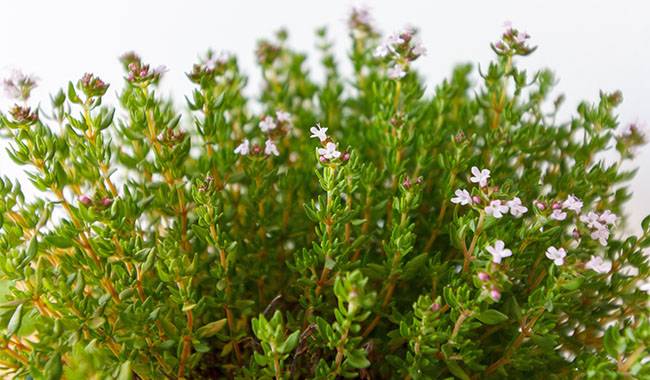
Among a large number of thyme, species are.
- The common ones. Comes to us from southern France and Spain. Characterized by small, lance-shaped leaves, dark green color, and delicate purple flowers.
- Prostrate (creeping). Mediterranean species with leathery leaves of various colors. The purple flowers have a beautiful pinkish hue. This thyme is frost and drought tolerant and is considered an excellent honeybee.
- Lemon scented. This is a hybrid from southern France, named for its lemony tart flavor. Over time, the yellow leaves turn green. The flowers are a delightful pink color. Poor frost tolerance needs shade during the cold season and regular pruning.
- Plant Honey. Foliage is strong, perennial hybrids are drought and cold resistant and productive. Excellent for beehives and garden decorations. Used fresh and dried, in cooking and folk medicine.
CUTTINGS OF THYME
“If it is a spontaneous decision to cultivate thyme in the window, X when there is no pot or soil mixture at home, green cuttings can be allowed to take root in a glass, which can be made of dark glass or specially blackened”
If you’re not ready for the long process of growing thyme from seed, you can try accelerated propagation. To get fresh spicy herbs, you need to stock up on potted plants, free up your windowsill and buy fresh thyme herbs from the supermarket. Follow the instructions
Bring a package of thyme, carefully unpack it, and select the best-preserved flowering branch from the total mass. Make a diagonal cut in the stem. This requires a sharp knife.
Tear off the leaves underneath and submerge the cuttings in water, allowing them to remain in the water for another five to six hours. This works very well if you use melted water heated to room temperature.
Adding honey (half a teaspoon is enough for half a liter of water) will promote better rooting.
While the cuttings are sitting in the water, prepare the pot. It should be scalded with boiling water and the bottom should be covered with clay pebbles. Drainage is watered with a layer of fertile soil. It should take up a third of the volume. The rest will be occupied by coarse-grained series of calcined sands. These are watered with a pink manganese solution.
In one pot, plant four cuttings per pot. After planting, they are sprayed with water and arranged in greenhouse conditions. The pots are covered with a half-liter jar, which you should remember to lift periodically to allow air to reach the shoots. The roots of the cuttings will form in about the second or third week. During this time, the jar will also be removed. Half a month from this point, the seedlings can be planted in their own containers with standard fertile soil.
In case of a spontaneous decision to cultivate thyme in the window, X when there are no pots or soil mixtures at home, green cuttings can be rooted in a glass, which can be made of dark glass or special dark glass.
Room temperature water saturated with activated charcoal tablets and a few grains of the hydrogel. As soon as the microclimate of the windowsill is dry and warm, the glass is placed in a polyethylene bag and filled with air in the latter and tied.
In such germination, roots will appear within 20 days. Transplant the seedlings into pots filled with light, fertile soil, taking care not to chip off the swollen hydrogel particles from the roots.
Thyme cuttings are rooted within 20 days.
Watering
Thyme should be watered moderately and only when the soil is sufficiently dry. Only young shoots should be planted on dry food.
Thyme bushes are planted in their second year when new shoots begin to emerge from the roots. Like allspice herbs, it responds to mineral fertilizers.
Thyme in winter
During this period, it is best to remove thyme from the windowsill and send it to a glass balcony, for example, to provide the plant with a period of rest. Only during frosty weather, when the temperature on the balcony is not too low, can it become a shelter.
Readings below -5°C (23°F) are a concern and the thyme has been moved to another warmer location
Practice and continuous baking thyme, but in this case, he needs to provide not only a warm window sill but also additional lighting.
HOW TO GROW IN THE GARDEN
Growing thyme in your own plot is not difficult. To do this, prepare seeds, cuttings, or divide the shrub. Active propagation by self-seeding should be taken into account, due to the need to deal with space constraints over time.
Thyme seeds
Seeds can be sown in places carefully cleared of weeds. Since small seeds germinate within a month and develop very slowly, weeds interfere with this process. Therefore, planting thyme is best done by the seedling method.
For this purpose, a mixture of sand and peat is prepared in early spring and poured into a box, tray, or container. After sowing, the seeds are kept under polyethylene or glass until the sprouts appear.
Sprouts need regular moderate watering and good light. after 3-4 weeks, the stronger-looking plants are hardened in the open air for two weeks and then planted in a permanent growing place.
Thyme from cuttings
In summer, propagate thyme from green cuttings. This method is characterized by successful rooting. The procedure is carried out before flowering. The top part of the stem should be cut to a height of 10 cm (3.93inch), placed in river sand, and covered with a piece of polyethylene. After a month, the rooted specimens can be planted in the open ground.
When dividing the shrub, pull the base apart and gently pull out the roots.
We recommend covering the slot with a glass jar for one week to promote rooting.
GROWING THYME
A hardy and undemanding semi-shrub that can be cultivated without causing trouble to the gardener. Thyme grass adapts to the climatic conditions proposed and copes with a can-do attitude by forming spherical bushes and increasing its useful mass.
SITE AND SOIL SELECTION
To grow thyme, it is necessary to choose a sunny and open place in the vegetable garden, but without draught. The soil should be neutral and well-drained.
Heavy soils, clayey soils, and strongly moist soils need Gaza. For grass to thrive in the open ground, it should not be acidic and chalk or lime should be added.
You need to consider the overall design of your garden so that the luxurious thyme weave blends harmoniously into the landscape.
WHEN AND HOW DO I PLANT THYME?
Planting thyme seeds is done in autumn and spring after soaking in warm water for 12 hours. Smear the shoots, keeping 30cm (11.8inch) intervals.
Seedlings are best planted after the end of frost on a warm, sunny day. Arrange a spacious hole. Remove the seedlings from the container and place them in a mixture of soil and sand.
Compact the surface of the soil and water the plants afterward. In case of propagation by cuttings, planting is done in August.
When thyme is grown from seed in the open ground, the semi-shrub will flower the following year.
In Asia, the flavor of thyme is a must in lamb dishes in all countries. This spice is also an irreplaceable ingredient in French cuisine.
Thyme is a genus of plants in the thyme family (Lamiaceae). The genus Thymus has a large number of species, including more than 350 species. More than 170 species of thyme can be found on the territory of Eastern Europe.
Not all species are herbaceous, as they vary greatly in color and odor. Thyme is called Thymus vulgaris. In natural conditions, thyme grows on dry mountain slopes.
So if grown in a home plot, it needs a sunny spot with plenty of light throughout the day. In the shade, or even in the penumbra, cultivars with unusually colored leaves lose this characteristic.
This plant looks like a compact shrub or semi-shrub up to 40cm (15.7inch) tall most commonly 15-20cm (5.9-7.87inch). The stems of thyme are woody, leafless, and recumbent or ascending.
The herbaceous branches have small pointed leaflets that arise from the stems. The flowering branches are erect. It is a perennial plant.
Thyme flowers from May to August. Its flowers are purple and pink, and there are also white-flowered varieties.
Gardeners often use thyme as a decorative plant. With its help decorate irregular plots. It is now a permanent resident of the popular aromatic garden.
The fruits of thyme are small, oval, smooth black, or dark brown nuts. Thyme has a slightly bitter and slightly spicy flavor with a pleasant and persistent aroma.
Thyme branches and leaves are picked, dried, and crushed. After such preparation and proper storage, the spice does not lose its flavor for two years.
This plant grows willingly on open ground and on windowsills.
Thyme is a great bee and is indispensable where there is an apiary. It also attracts insects for pollination if some shrubs are planted near or in greenhouses.
SEEDS OF THYME
To grow a spicy plant at home, you don’t have to spend money on seedlings, which, by the way, are still very easy to find. It’s much easier to use seeds. Potted thyme grows properly on a sunny balcony, as well as on a windowsill, with a system of regular ventilation.
THYME IS PERFECT FOR PLANTING ON WINDOWSILLS
Action plan.
- Prepare a small pot 15cm (5.9inch) deep.
- Just cover the bottom with a 2cm (0.78inch) layer of drainage pipe.
- Prepare the soil. Mix with vermiculite.
- Wet the soil in the sprayer and place it on top of the drain.
- Shade the pot until the first shoots appear. This will make the seedlings more robust and less likely to be burned in the sunlight.
Thyme seeds germinate very well, so you can leave the strongest shoots to grow and discard the rest.
FIND A PLACE WHERE I BELONG
Light, non-acidic soils are suitable for growing thyme. Soil reaction should be slightly alkaline, close to herbaceous. The soil should be well-drained, loose, and airy.
Like most pungent plants, thyme is very demanding of light and is not afraid of direct sunlight. It grows in open, sunny areas.
Thyme is a hardy plant. However, it does not like drafts and north winds. Therefore, thyme must be planted in a place that is sheltered from strong winds. You can place a thyme mini-planting garden behind a berry bush.
Fertilizer is mainly organic. However, if you use manure, this organic matter is applied only in the fall under digging. In the spring, before planting, methane is introduced into the soil intended for thyme.
Thyme does not tolerate “overwatering” and does not like to have standing water on its roots. This drought-tolerant plant does not require heavy watering. It only needs watering during periods of drought.
DISEASES AND PESTS
The aromatic substances released by thyme in large quantities act as a good defense against pests. If not cared for according to good care instructions, it can trigger attacks by insects.
Those that cause significant damage to the plant are.
Straw bags, which damage the stems and leaves. Activated by warm nights. Insecticide treatments help.
Sand bumblebees completely destroy the above-ground organs. Control them with poisonous baits.
Weevil. Feed on young shoots and flower buds. Plants can be protected by insecticide treatment or by setting baits with poisonous preparations.
Aphids damage the stems and leaves of thyme. It is not resistant to insecticides.
Measures to prevent pests and parasites are regular loosening of the soil, timely removal of weeds, deep digging, and alkaline fertilization.
PLANTING CONDITIONS
The thymus is propagated by seeds, seedlings, and cuttings.
Even in our latitudes, it is possible to sow seeds directly in the open ground or in a greenhouse. The seeds are sown at a distance of 15-20cm (5.9-7.87inch) and in rows about 35cm (13.7inch) apart. The seeds are sown at a depth of 0.5cm (0.19inch).
Seeds are sown in March, and seedlings are planted in the soil in early spring. Seeds are not soaked before sowing. Dry seeds are placed in the soil to a depth of about 1cm (0.39inch). When planting seedlings, take into account a row spacing of at least 45cm (17.7inch). You can propagate thyme by dividing the bushes (it is better to do it in spring).
Thyme needs good care. Be prepared by regularly loosening the soil between the rows and directly around the bushes. Water on dry days and keep weeding. Especially important is the control of weeds during the bok choy harvesting activities to facilitate harvesting.
At first, thyme development is less active. The first year requires constant and thorough weeding and loosening of the soil, as well as regular and moderate watering. Feeding in the first year is not done. In the second or third year, humus and mineral complex fertilizers are introduced into the soil.
Planting thyme is recommended to be renewed after 3 to 4 years.
HOW TO GROW THYME AT HOME?
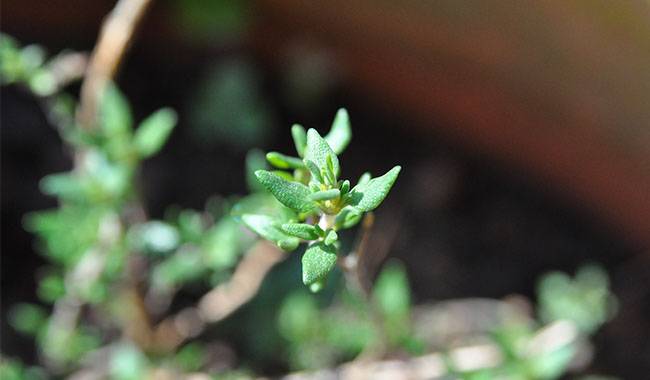
There are several common ways to grow thyme. When propagating the spice in the living room, it can be grown by cuttings or sowing seeds. To choose the best growing method for you, it is important to understand each growing method in detail.
Starting from seeds
It is most common to grow spices from seeds, as it is relatively easy. To do this, pour soil mixed with vermiculite, which improves the moisture retention of the soil, into a pre-prepared container.
Then water the soil in the container with warm water and make holes in the ground. Put 2-3 seeds in each hole and fill with soil. Transfer the planted plants to the windowsill and water them regularly. When the first buds appear in the pot, thin them for better growth.
Cuttings
Some people like to propagate thyme bushes from cuttings. First, you need to get busy preparing the cuttings for planting. After the thyme has finished flowering, cut off the shoots from the bush and strip the leaves completely. Cut off the frequent shoots and take the cuttings and plant them in pots.
Planting thyme cuttings in the ground is simple. To do this, the pot is completely filled with soil and a 1-2cm (0.39-0.78inch) deep depression is made in it. Then, put sprouts in the wells and cover them with soil. The planted cuttings are watered within 1-2 days until the first leaves appear.
Time for harvesting cuttings
Leaves and shoots should be harvested several times during the growing season. Shoots are cut at 5cm (1.96inch) from the ground. After that, the plants are fed.
As a spice for cooking, the main harvesting time for the tops is at the end of June and July. The flowering shoots are used for medicinal purposes. Thyme seeds are harvested from two to three-year-old plants. The seeds are mature when they turn brown. Thyme is placed in a cool place, spread on a clean cloth or paper, and dried naturally.
Siting of indoor thyme
Some inexperienced housewives pay little attention to choosing a suitable planting location because they believe that the spice will grow in any room. However, this is not the case, so you should familiarize yourself with the peculiarities of choosing the best place to grow thyme.
Lighting
Thyme is considered a light-loving plant that grows best in the presence of sunlight. It is recommended to place the pot with the plant on a sunny windowsill. If growing spices in winter, take care to increase lighting and install special lamps.
Temperature and air humidity
Thyme grows better in a cool room with air temperatures no higher than 20°C (68°F) hot. In autumn, you can take the pots to the glazed balcony during the day and bring them into the apartment only in the evening, after the sun has set. In wintertime, you cannot take the spices to the balcony because the low temperature will kill them.




